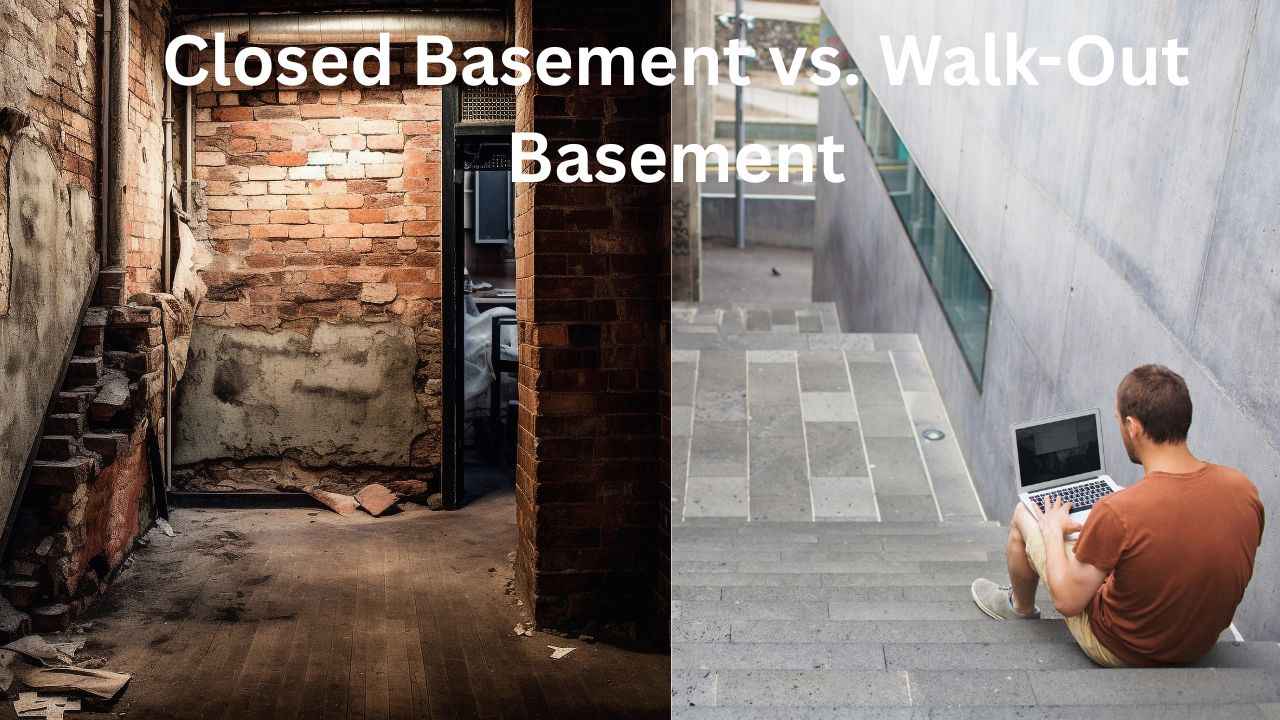So, you’re probably wondering, “What is a closed basement?” It sounds pretty simple, right? But there’s actually a lot more to it than just a basement that’s… well, closed.
Let’s dive into it together — no construction hat required!
First Off, What Exactly Is a Closed Basement?
A closed basement is a basement that has no exterior door or direct exit to the outside. That means if you’re down there and want to go out, you’ve got to walk back upstairs first. There’s no sneaky side door or back patio exit like you’d see in a walk-out basement or a walk-in basement.
Think of it like being inside a box — cozy, sealed, and fully underground.
In other words, this type of basement sits completely below ground level, and the only way in or out is through the house itself. That’s why people often ask about things like whether the basement door should be open or closed in winter, or if they should close basement vents in summer — because airflow and temperature control matter more when your basement is all sealed in.
Understanding the Closed Basement Foundation
Now, let’s talk about what’s holding this thing up: the closed basement foundation.
This foundation is typically made of poured concrete or concrete blocks. It wraps around your basement like a giant protective hug, keeping soil and moisture out. Since it’s fully underground, this foundation must be extra strong and tightly sealed.
You’ll often hear contractors recommend closed cell spray foam for basement walls or closed cell spray foam basement insulation. Why? Because it keeps the heat in during winter and the dampness out during summer. Some even go for closed cell foam basement walls because they’re tough, mold-resistant, and energy-saving.
Should You Open or Close Basement Vents?
Okay, let’s get into a hot (or cold) debate.
Should you close basement vents in summer?
Can you close vents in the basement?
What about winter — should you close all vents in basement then?
So many questions. Don’t worry — we’ve got answers!
In Summer:
When it’s blazing hot outside, many folks ask,
“Can I close my basement vents in summer?”
Or
“Should I close basement vents in summer?”
Here’s the deal: closing vents might seem like a smart move, especially if your basement is already cooler than the rest of the house. But here’s the twist — doing that can mess up your air circulation and even damage your AC system. Some experts suggest partially closing vents to redirect air but never close all vents in basement entirely.
So if you’re wondering, “Can I close basement vents in summer?”, go easy. A little adjustment? Sure. Total shutdown? Nope.
In Winter:
Now let’s flip the switch to those chilly months.
Close basement vents in winter or leave them open?
Well, if your basement feels like a freezer, it might be tempting to shut off the vents. But again, bad move. Keeping basement vents open or closed in winter affects how warm or cold your house feels upstairs too.
A warm basement helps keep your whole home cozy. So if you’ve been Googling things like “how to close basement ceiling vents” or “how to close basement vents”, just remember — complete closure might make things worse.
Basement Door Open or Closed?
Alright, let’s talk doors.
You’re walking through your house and stop at the basement door. You pause and think:
- “Should the basement door be open or closed?”
- “Basement door open or closed in summer?”
- “Basement door open or closed in winter?”
Oh, the basement door drama!
Let’s break it down by seasons.
In Summer:
In hot weather, a basement is usually much cooler than the rest of the house. Leaving the basement door open in summer might let that cool air travel upstairs — like free air conditioning! But it could also cause humidity problems, especially if the basement isn’t properly ventilated.
In Winter:
Here’s where it gets a little weird. Some people swear their furnace turns on when the basement door is closed. That’s not magic — it’s airflow. Your HVAC system relies on movement, so closing the basement door when the furnace turns on can affect efficiency. That’s why you might wonder about basement vents open or closed and why that door matters.
TL;DR? Try to keep airflow natural. Don’t shut your basement off from the rest of the house.
Windows: Open or Closed?
Basement windows often feel like the unsung heroes. They’re small, dusty, and sometimes forgotten.
But if you’ve ever asked,
“Should basement windows be open or closed?” — you’re not alone.
In a closed basement, windows play a big role in ventilation and humidity control. Opening them occasionally can help freshen things up. But be careful — too much outside air can bring in moisture, especially in humid seasons.
If your window doesn’t open or is too drafty, some homeowners decide to close off the basement window entirely for energy savings. Just make sure you’re not violating any building codes, especially if it’s meant to be an emergency exit!
What About the Stairs?
Now this one’s often overlooked — but super important.
How to close in basement stairs?
Or
Should you close off basement stairs to save energy?
When you close off basement stairs, you’re trying to separate your upstairs climate from the downstairs. This can help if you’re heating or cooling just one area, but it may also disrupt the natural flow of your home’s air.
Think of your house as one big lung. Block part of it off, and the rest has to work harder to breathe.
Wait, Did Someone Say “Basement Jaxx – Close Your Eyes”?
Haha, yes! Believe it or not, folks sometimes land on closed basement articles when searching for things like “Basement Jaxx – Close Your Eyes” or even “What time does Sports Basement close”.
Fun fact: Sports Basement is a real store. If you searched “when does Sports Basement close” or “what time does Sports Basement close”, you might’ve ended up here by mistake — but hey, now you know what a closed basement is!
Closed Basement vs Slab
Before we wrap this up, let’s tackle one more quick comparison:
Closed basement vs slab foundation.
A slab is a big flat chunk of concrete that sits directly on the ground — no basement, no crawl space, nada. It’s cheaper and faster to build but gives you zero extra space.
A closed basement, on the other hand, gives you storage, living space, maybe even a home theater — as long as it’s dry and safe!
Closed Basement vs. Walk-Out Basement — Which One Is Better?
So you’ve heard about a closed basement, but now someone throws around the term walk-out basement, and you’re like… wait, what?
Don’t worry — we’re going to compare the two basement types side by side, so you can see exactly what makes them different and which one might be a better fit for your home (or your dream home!).
What’s the Basic Difference?
Let’s start with the big picture.
- A closed basement is fully underground. It has no exterior door or exit to the outside. You get in and out through the stairs inside your house.
- A walk-out basement has at least one wall above ground. That means you can open a door from the basement and literally walk out into your backyard or side yard.
Pretty simple, right?
Still, there’s a lot more to consider — things like cost, light, airflow, safety, and design potential.
Structure: How They’re Built
Closed basements are surrounded by earth on all sides. Their foundation sits deeper, so you get full coverage from the ground. This kind of construction is great for insulation — like nature’s own blanket. But because it’s closed off, airflow and moisture control are trickier.
You’ll often need good sealing, ventilation, and maybe even closed cell spray foam for basement walls to keep things dry and comfy.
Walk-out basements, on the other hand, are built on a slope. One side is underground like a regular basement, but the other side is at or just above ground level. That exposed side usually has a sliding glass door or even a patio.
You’ve probably seen houses on hills where the back door leads straight into the basement — that’s a walk-out!
Light & Airflow
Here’s where the difference really shines — literally.
- A closed basement is like a cave — cozy, cool, but kind of dark. You’ll need artificial lighting (think LEDs, recessed lights, or daylight bulbs) to brighten it up.
- A walk-out basement can feel more like a regular living space. Big windows and doors bring in sunshine and fresh air. You might even get a nice view of your backyard.
People who live in closed basements often ask,
“Should basement windows be open or closed?”
That’s because airflow and moisture are constant issues in these sealed spaces.
You may also wonder about keeping basement vents open or closed in summer or winter — which, spoiler alert, we’ll talk more about in the next section.
Cost & Value
A closed basement is usually more affordable to build, especially if your land is flat. There’s less excavation, fewer structural complexities, and no need for a big door or stair system leading outdoors.
But here’s the catch — it could be more expensive to finish later. Why? You’ll need to install better ventilation, moisture protection, and possibly even close off basement stairs to manage airflow.
A walk-out basement, on the other hand, costs more up front (thanks to things like grading and retaining walls), but it can dramatically boost your home’s resale value. Why? Because it adds light, livability, and feels more like a main-level room than a basement.
Buyers love basements that don’t feel like basements.
Use & Design Flexibility
A walk-out basement opens up tons of options. You could:
- Turn it into a rental apartment (with its own entrance!)
- Build a guest suite or in-law unit
- Make it a home office with direct access to the yard
In a closed basement, you still have awesome design choices — like a theater, a gym, a game room, or an extra living room — but you’ll have to work harder to make the space feel bright and welcoming.
A lot of folks ask things like:
“Can I close my basement vents in summer?”
Or
“How to close basement vents without hurting airflow?”
These questions pop up more with closed basements because they don’t breathe like walk-outs do. So comfort depends heavily on your ventilation and temperature setup.
Safety & Emergency Access
This one’s important.
Because a closed basement has no door to the outside, it must have something called egress windows in case of an emergency — especially if someone sleeps down there. That’s the law in many areas.
In contrast, a walk-out basement already has a full exit, so it’s considered safer and more code-friendly if you want to add bedrooms or living spaces.
You also might consider whether to close off the basement window or install better window wells — again, especially important in closed basements.
Energy Efficiency
Let’s talk comfort and bills.
Closed basements tend to stay cool in summer and warm in winter — thanks to being surrounded by dirt. That’s why they’re great at energy efficiency if they’re sealed properly with things like closed cell spray foam basement insulation.
But because they’re sealed tight, airflow and humidity can be a headache. That’s why many homeowners ask:
“Should you close basement vents in summer?”
“Can you close air vents in basement without messing up the system?”
The answer is: maybe — but you’ll want to monitor humidity and temperature to keep things balanced.
Walk-out basements get more air and sun, which feels nice but may raise your cooling costs in hot climates.
Quick Comparison Table
| Feature | Closed Basement | Walk-Out Basement |
|---|---|---|
| Light | Low (needs help) | High (natural) |
| Airflow | Limited | Great |
| Cost | Lower upfront | Higher upfront |
| Exit | No outdoor access | Door to outside |
| Best for | Storage, theater, gym | Apartment, office, guest suite |
| Resale Value | Moderate | High |
| Humidity Risk | Higher | Lower |
| Energy Efficiency | Good with insulation | Depends on windows/doors |
So… Which One’s Right for You?
It really depends on your home site, budget, and what you plan to do with the space.
Choose a closed basement if:
- Your lot is flat and fully underground is the only option
- You want lower construction costs
- You plan to use the space mostly for storage or quiet hobbies
- You’re okay with investing in better ventilation and lighting
Choose a walk-out basement if:
- Your home sits on a slope
- You want to create a bright, livable, and accessible space
- You may rent it out or use it as a private suite
- You’re willing to spend more for long-term value
Either way, just remember to manage things like:
- Basement vents open or closed in summer
- Basement door open or closed when furnace is on
- How to close off basement stairs if needed for energy control
- And how to deal with moisture, windows, and insulation
Final Take
So, in the battle of closed basement vs. walk-out basement, there’s no one-size-fits-all answer.
But now you know exactly how to make the choice that fits your lifestyle, location, and goals.
Up next? We’ll dive deeper into the pros and cons of a closed basement — so you’ll know exactly what you’re getting into if you choose to go the cozy, closed-in route.




